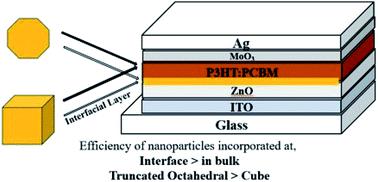Our official English website, www.x-mol.net, welcomes your
feedback! (Note: you will need to create a separate account there.)
Understanding the effects of shape, material and location of incorporation of metal nanoparticles on the performance of plasmonic organic solar cells
RSC Advances ( IF 3.9 ) Pub Date : 2020-7-10 , DOI: 10.1039/d0ra04076b Minu Mohan 1 , Ramkumar Sekar 1 , Manoj A G Namboothiry 1
RSC Advances ( IF 3.9 ) Pub Date : 2020-7-10 , DOI: 10.1039/d0ra04076b Minu Mohan 1 , Ramkumar Sekar 1 , Manoj A G Namboothiry 1
Affiliation

|
Truncated octahedral gold (Au) nanoparticles (NPs), Au nanocubes (NCs)-, and silver (Ag) NCs are used to study the effect of NPs shape, material and incorporation location on the performance of poly(3-hexylthiophene):[6,6]-phenyl-C71-butyric acid methyl ester (P3HT:PC71BM) based inverted bulk heterojunction (BHJ) organic solar cells (OSCs). Plasmonic OSCs (POSCs) with NPs incorporated as an interfacial layer between zinc oxide (ZnO) and active layer showed highest power conversion efficiency (PCE) and short circuit current density (Jsc) values for all kind of shapes and material compared to POSCs with NPs blended into the active layer. Near-field enhancement as well as enhanced forward scattering cross section is attributed for POSC performance improvement. Among the NPs with two shapes, POSCs with truncated octahedral Au NPs exceeded the photovoltaic performance compared to those of POSCs with Au and Ag NCs. Large number of antennas in truncated octahedral Au NPs compared to NC is reasoned to be the cause for this improvement. Even though Ag has better localised surface plasmon resoanance (LSPR) properties compared to Au, the POSCs with Ag NCs showed lower Jsc value and is due to reduced number of photons at the blue shifted LSPR wavelength of Ag NCs. The improvement in Jsc values of POSCs is confirmed by enhancement in absorption, external quantum efficiency (EQE), exciton generation and exciton dissociation probability measurements and is due to improved LSPR coupling of the NPs with the active layer. The surface enhanced Raman scattering (SERS) and photoluminescence (PL) studies confirm the absorption enhancement in the active layer by NP LSPR coupling and further confirm the enhancement in the photovoltaic performance of POSCs.
中文翻译:

了解金属纳米粒子的形状、材料和掺入位置对等离子体有机太阳能电池性能的影响
截断八面体金 (Au) 纳米粒子 (NPs)、Au 纳米立方体 (NCs) 和银 (Ag) NCs 用于研究 NPs 形状、材料和掺入位置对聚 (3-己基噻吩) 性能的影响:[基于6,6]-苯基-C 71 -丁酸甲酯 (P3HT:PC 71 BM) 的反向本体异质结 (BHJ) 有机太阳能电池 (OSC)。将 NP 结合为氧化锌 (ZnO) 和活性层之间的界面层的等离子体 OSC (POSC) 显示出最高的功率转换效率 (PCE) 和短路电流密度 ( J sc) 与将 NP 混合到有源层中的 POSC 相比,各种形状和材料的值。近场增强以及增强的前向散射截面归因于 POSC 性能的改进。在具有两种形状的 NPs 中,与具有 Au 和 Ag NCs 的 POSCs 相比,具有截断八面体 Au NPs 的 POSCs 超过了光伏性能。与 NC 相比,截断八面体 Au NP 中的大量天线被认为是这种改进的原因。尽管与 Au 相比,Ag 具有更好的局部表面等离子体共振 (LSPR) 特性,但具有 Ag NCs 的 POSCs 显示出较低的J sc值,这是由于 Ag NCs 的蓝移 LSPR 波长处的光子数量减少。J sc的改进POSCs 的值通过吸收、外部量子效率 (EQE)、激子产生和激子解离概率测量的增强得到证实,并且是由于 NPs 与有源层的改进的 LSPR 耦合。表面增强拉曼散射 (SERS) 和光致发光 (PL) 研究证实了 NP LSPR 耦合在有源层中的吸收增强,并进一步证实了 POSC 光伏性能的增强。
更新日期:2020-07-10
中文翻译:

了解金属纳米粒子的形状、材料和掺入位置对等离子体有机太阳能电池性能的影响
截断八面体金 (Au) 纳米粒子 (NPs)、Au 纳米立方体 (NCs) 和银 (Ag) NCs 用于研究 NPs 形状、材料和掺入位置对聚 (3-己基噻吩) 性能的影响:[基于6,6]-苯基-C 71 -丁酸甲酯 (P3HT:PC 71 BM) 的反向本体异质结 (BHJ) 有机太阳能电池 (OSC)。将 NP 结合为氧化锌 (ZnO) 和活性层之间的界面层的等离子体 OSC (POSC) 显示出最高的功率转换效率 (PCE) 和短路电流密度 ( J sc) 与将 NP 混合到有源层中的 POSC 相比,各种形状和材料的值。近场增强以及增强的前向散射截面归因于 POSC 性能的改进。在具有两种形状的 NPs 中,与具有 Au 和 Ag NCs 的 POSCs 相比,具有截断八面体 Au NPs 的 POSCs 超过了光伏性能。与 NC 相比,截断八面体 Au NP 中的大量天线被认为是这种改进的原因。尽管与 Au 相比,Ag 具有更好的局部表面等离子体共振 (LSPR) 特性,但具有 Ag NCs 的 POSCs 显示出较低的J sc值,这是由于 Ag NCs 的蓝移 LSPR 波长处的光子数量减少。J sc的改进POSCs 的值通过吸收、外部量子效率 (EQE)、激子产生和激子解离概率测量的增强得到证实,并且是由于 NPs 与有源层的改进的 LSPR 耦合。表面增强拉曼散射 (SERS) 和光致发光 (PL) 研究证实了 NP LSPR 耦合在有源层中的吸收增强,并进一步证实了 POSC 光伏性能的增强。











































 京公网安备 11010802027423号
京公网安备 11010802027423号